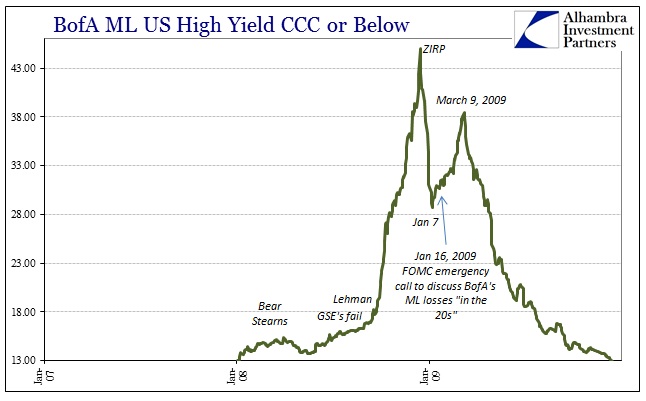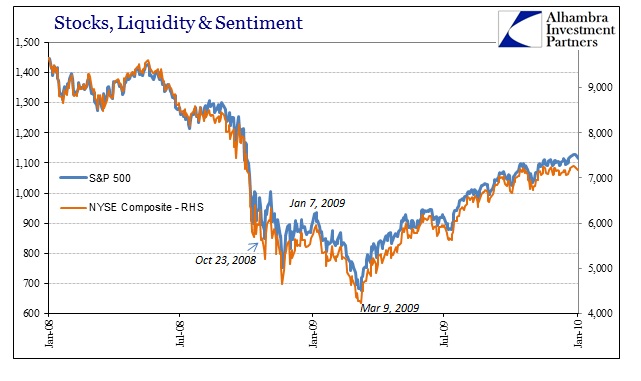On January 16, 2009, the FOMC gathered telephonically for an emergency conference call to discuss a deal that had been struck between Bank of America (NYSE:BAC) and the FDIC, Federal Reserve, and the US Treasury Department. There was enormous concern, quite well-founded, that had nothing been done, the news of that day might have led to a place nobody wanted to go.
Specifically, in terms of BofA, that had already been the case as Merrill Lynch had been shepherded into a “cold fusion” whereby BofA’s supposedly superior resources and standing would be able to absorb all the impending trouble lurking still on ML’s balance sheet. What they were now considering was having bailed out the ML’s of the world, the large but mostly shadow/wholesale banks, might they have to go further and do the same with the true behemoths?
Merrill was likely going to be a casualty of those tumultuous weeks in September 2008, starting when the GSEs were taken into “conservatorship” and the next week when Lehman ran aground of illiquidity. The last Friday that Lehman was in business, Merrill was already in talks to be sold to BofA; an announcement of those talks was made that crucial Sunday, September 14.
The merger would close on January 1, 2009, but already there was big trouble. The FOMC’s General Counsel Scott Alvarez actually led off the conference call (after being introduced, as is custom, by the Chairman’s opening) which already suggested unusual conditions. News of the financial (bailout) arrangement between the various government agencies and BofA had already leaked before the Committee had any chance to comment or voice any objections. The speed of events was necessary because of the scale of the losses announced by BofA, including greater than expected from its own operations pre-merger.
The real hammer, however, was Merrill Lynch’s huge crater, which Mr. Alvarez characterized as, “in the mid-20’s pretax.” It is extremely difficult to lose that much in any single quarter and only a few institutions, notably Citi, managed to do it. The government was afraid that such a massive writedown (and any cash considerations that would come of it) would shake any confidence left in BofA, especially since the merger was barely a few weeks in place and that BofA was already shaky to begin with, “one of the more thinly capitalized banking organizations, so losses for them are taken pretty seriously.”
The timing of this discussion was perhaps the most meaningful, and it was not lost on Chairman Bernanke. This was not supposed to happen, not after everything that had been done especially after Lehman which was at that point already four months in the rear-view. Bernanke was simply befuddled, admitting, “But for whatever reason, our system is not working the way it should in order to address the crisis in a quick and timely way.”
In other words, nothing the Fed did had any sustained, relevant effect. In the specific case of Merrill Lynch, the Chairman described to the Committee the frightening pace of the deterioration for BofA:
“This whole situation was stimulated by a call from Ken Lewis just a few weeks ago to the effect that the losses that Merrill Lynch was going to report at the end of the fourth quarter had risen on the order of $10 billion or $15 billion in just a couple of weeks, in terms of what they were reporting to Bank of America.”
The Fed had committed to QE in late November, voted for ZIRP on December 16, 2008, along with a further statement directed at the “markets” that the Fed was already considering expanding QE1 in agency and MBS securities, as well as adding the purchase of longer-term UST’s. How could Merrill Lynch’s losses accelerate under those promises of “money printing?” Bank of America in its earnings statement bluntly specified that ML’s losses were, “driven by severe capital market dislocations” especially late in the quarter. Under the terms of FAS 157 as they existed at the time, ML was marking asset prices based on any observable inputs no matter how bad; meaning illiquid pricing was still wreaking havoc (it must have been disastrously so, given that the loss projections increased $10 or $15 billion in only a few weeks even after ZIRP) deep within the bowels of the wholesale financial system.
On the outside, markets were far more encouraged by the “money printing.” Stocks had suffered in October and then again in November, but had largely stabilized through the rest of the year as monetary promises only got larger. Junk bonds, which had been sold to an unbelievable extreme, were bid especially strong especially on the double news of December 16. In many ways, this wasn’t surprising since distressed debt is by far the best performing asset class (historically) after any crisis or crash – it is all high risk, high reward.


The timing of the bargain hunting seemed quite rational given both the “money printing” commitment of the Fed and the fact that the economy at the time (in the mainstream view) seemed to be weathering the financial storm reasonably well. The NBER didn’t actually declare recession until December 1, 2008, and even a few weeks later when the FOMC gathered to discuss ZIRP there was (somehow) still quite a bit of optimism that it wouldn’t be as bad as some feared (denial is very powerful, especially when coupled with recency bias). For junk bonds in particular, it seemed the perfect buy signal.
It all went wrong again starting January 7, 2009, ironically the day that the minutes from the December 16 FOMC meeting were released. In other words, the results of that meeting were highly encouraging (especially to junk bonds) but the discussions that led to the decisions were crushing. Maybe that should have been apparent all along, as at some point you would think even speculators would consider why the FOMC at that moment chose to “go all the way” rather than just blindly believe it would work enough for the economy to continue to escape the worst cases. What the minutes showed was that even the FOMC, long a bastion of that mainstream optimism, turned to expanding QE and ZIRP not as means to avoid those worst cases but rather with an aim to manage getting through them. In short, it was no longer “if.”
They [the Committee] agreed that maintaining a low level of short-term interest rates and relying on the use of balance sheet policies and communications about monetary policy would be effective and appropriate in light of the sharp deterioration of the economic outlook and the appreciable easing of inflationary pressures. Maintaining that level of the federal funds rate implied a substantial further reduction in the target federal funds rate. Even with the additional use of nontraditional policies, the economic outlook would remain weak for a time and the downside risks to economic activity would be substantial. [emphasis added]
The minutes record that some members further expressed what amounted to surrender on the economic question, as current (not future) circumstances justified further inclusion in the policy statement, “that weak economic conditions were likely to warrant exceptionally low levels of the federal funds rate for some time.” Everything sold off from there, not reaching the ultimate end of the systemic liquidation for another two months of devastation.
The problem was twofold, both factors of which were in many ways self-reinforcing. Though markets had been devastated already, there was far too much unrealistic sanguinity that it just could never get that bad because it hadn’t at least since the Great Depression (recency bias). The second factor was liquidity; it never responded positively to anything the Fed did, including the very fact of the panic in the first place. As the sharp trajectory of ML’s losses even after ZIRP demonstrated, “better” is not the same as “fixed.” We can see this disparity in the 30-year swap spread:

Though it had bottomed out on November 21, 2008 (the same as stocks), volatility remained extreme and the spread (and the entire swap curve, for that matter) highly compressed even though it had managed a return to positivity on December 22. Liquidations are the combination of illiquidity and selling sentiment; liquidity remained highly impaired and though the Fed seemingly gave “markets” positive sentiment on December 16 they then justified severe reversal on January 7. The result was that last leg of the panic/liquidations and the further, shocking economic damage that went with it.
Liquidity is an extremely important factor, which is why I spend so much time and effort analyzing and trying to figure out its actual state (subscription required) beyond the cursory sweep of the most apparent market prices. Liquidity in systemic terms is the ability of the system to reasonably absorb any shift in sentiment toward more sustained selling, to take on an increase in margin (and collateral) calls such that they do not snowball into the avalanche. That function is all the more important in periods where great fundamental uncertainty abounds, because during those times sentiment can shift seemingly in the blink of an eye.
In reality, sentimental usually shifts back and forth just that quickly, only those times never seem to matter or cause global disruption – until they meet in the perfect storm of uncertainty and illiquidity.
